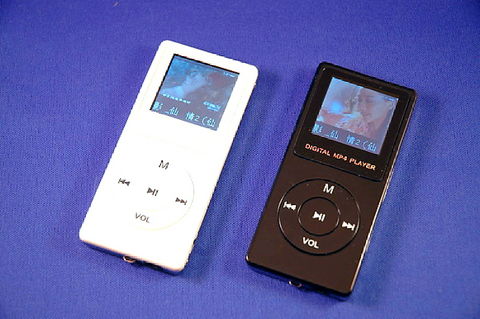As young consumers scramble to snap up Apple Computers' iPod series of portable music players, imitation products have inevitably popped up on the market. Some of these, only available through somewhat circuitous channels over the Internet, sail very close to the wind in imitating Apple's now iconic products.
These rip-offs can cost as little as half the price of the real thing, and their functions and appearance are, at first glance, indisting-uishable from real iPods. The giveaway is that they are currently only available online or after setting up an appointment.
These imitation iPods go under the name of the Nano Apple. According to a representative of the manufacturer, who would only give her surname as Chang, the devices are manu-factured in China and marketed in Taiwan under a number of different brands.

PHOTO: TAIPEI TIMES
The Nano Apple is available in three different storage capacities: 512 MB, 1GB, 2GB. If you don't look carefully, the device could easily be mistaken for original Apple iPod nanos. The most noticeable difference is that instead of "Menu," which is written on the iPod nano's dial, the Nano Apple has an "M." Also, the Nano Apple's "play" button is in the center of the dial, and volume is controlled at the bottom of the dial. Both have 1.5-inch screens, and despite the slight alteration in the placement of the function keys, the look, finish and feel of the devices makes them indisting-uishable from Apple Computer's product to the casual observer.
And of course, these knock-offs are considerably cheaper than the iPod. While the 1G iPod nano, the model with the smallest storage capacity, retails for NT$5,300, the 1G knockoff sells for NT$2,300. What's more, the knockoffs have video capability, a feature which is only available in 30G and 60G video iPods, which retail for over NT$10,000.
Despite some concerns about quality, it is no surprise that the Nano Apple is flying off the shelf, so to speak, and sites selling the device online have difficulty keeping up with demand. Anecdotal evidence also suggests that these
attractive looking knockoffs appeal to Taiwan's style-conscious youth.
For those who value function-ality over fashion cachet, it is worth noting that the smallest Nano Apple only has a meager storage capacity of 512M, and has a significantly shorter battery life than the iPod nano. Nevertheless, for those simply looking to get the latest gimmick, the knockoffs offer a cheap option. When contacted by the Taipei Times, Apple Computers refused to comment on the imitation music players.
Chinese-language media reports have suggested that the knockoff nanos do not have the same guarantee of quality as the originals, pointing out that they are made in China. Apple's own iPods are also made in China, and in a phone interview with Taipei Times, Chang said that her company, also provided full after service. According to Chang, the Nano Apple can be returned within seven days of purchase with the original receipt and packaging for a full refund.
"We provide after-sales service and irresistible functions that a real iPod nano is not able to offer. It is a simply a matter of supply and demand," said Chang.

Oct. 27 to Nov. 2 Over a breakfast of soymilk and fried dough costing less than NT$400, seven officials and engineers agreed on a NT$400 million plan — unaware that it would mark the beginning of Taiwan’s semiconductor empire. It was a cold February morning in 1974. Gathered at the unassuming shop were Economics minister Sun Yun-hsuan (孫運璿), director-general of Transportation and Communications Kao Yu-shu (高玉樹), Industrial Technology Research Institute (ITRI) president Wang Chao-chen (王兆振), Telecommunications Laboratories director Kang Pao-huang (康寶煌), Executive Yuan secretary-general Fei Hua (費驊), director-general of Telecommunications Fang Hsien-chi (方賢齊) and Radio Corporation of America (RCA) Laboratories director Pan
The consensus on the Chinese Nationalist Party (KMT) chair race is that Cheng Li-wun (鄭麗文) ran a populist, ideological back-to-basics campaign and soundly defeated former Taipei mayor Hau Lung-bin (郝龍斌), the candidate backed by the big institutional players. Cheng tapped into a wave of popular enthusiasm within the KMT, while the institutional players’ get-out-the-vote abilities fell flat, suggesting their power has weakened significantly. Yet, a closer look at the race paints a more complicated picture, raising questions about some analysts’ conclusions, including my own. TURNOUT Here is a surprising statistic: Turnout was 130,678, or 39.46 percent of the 331,145 eligible party

The classic warmth of a good old-fashioned izakaya beckons you in, all cozy nooks and dark wood finishes, as tables order a third round and waiters sling tapas-sized bites and assorted — sometimes unidentifiable — skewered meats. But there’s a romantic hush about this Ximending (西門町) hotspot, with cocktails savored, plating elegant and never rushed and daters and diners lit by candlelight and chandelier. Each chair is mismatched and the assorted tables appear to be the fanciest picks from a nearby flea market. A naked sewing mannequin stands in a dimly lit corner, adorned with antique mirrors and draped foliage

The election of Cheng Li-wun (鄭麗文) as chair of the Chinese Nationalist Party (KMT) marked a triumphant return of pride in the “Chinese” in the party name. Cheng wants Taiwanese to be proud to call themselves Chinese again. The unambiguous winner was a return to the KMT ideology that formed in the early 2000s under then chairman Lien Chan (連戰) and president Ma Ying-jeou (馬英九) put into practice as far as he could, until ultimately thwarted by hundreds of thousands of protestors thronging the streets in what became known as the Sunflower movement in 2014. Cheng is an unambiguous Chinese ethnonationalist,